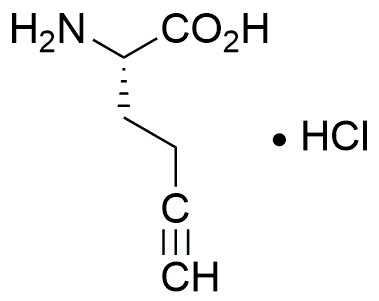L-Homopropargylglycine hydrochloride is widely utilized in research focused on various applications:
- Biochemical Research: This compound serves as a potent inhibitor of cystathionine γ-lyase, making it valuable for studying sulfur amino acid metabolism and its implications in diseases such as cancer.
- Neuroscience: Researchers use it to explore its neuroprotective effects, particularly in models of neurodegenerative diseases, helping to understand mechanisms of neuronal survival.
- Pharmaceutical Development: Its unique structure allows for the design of novel drugs targeting metabolic pathways, offering potential advantages over traditional compounds in specificity and efficacy.
- Plant Biology: In agricultural studies, it aids in understanding plant responses to stress, contributing to the development of crops that can better withstand environmental challenges.
- Analytical Chemistry: The compound is employed in various assays to measure enzyme activity, providing insights into metabolic disorders and potential therapeutic targets.
Informations générales
Propriétés
Sécurité et réglementation
Applications
L-Homopropargylglycine hydrochloride is widely utilized in research focused on various applications:
- Biochemical Research: This compound serves as a potent inhibitor of cystathionine γ-lyase, making it valuable for studying sulfur amino acid metabolism and its implications in diseases such as cancer.
- Neuroscience: Researchers use it to explore its neuroprotective effects, particularly in models of neurodegenerative diseases, helping to understand mechanisms of neuronal survival.
- Pharmaceutical Development: Its unique structure allows for the design of novel drugs targeting metabolic pathways, offering potential advantages over traditional compounds in specificity and efficacy.
- Plant Biology: In agricultural studies, it aids in understanding plant responses to stress, contributing to the development of crops that can better withstand environmental challenges.
- Analytical Chemistry: The compound is employed in various assays to measure enzyme activity, providing insights into metabolic disorders and potential therapeutic targets.
Documents
Fiches de données de sécurité (FDS)
La FDS fournit des informations de sécurité complètes sur la manipulation, le stockage et l’élimination du produit.
Spécifications du produit (PS)
Le PS fournit une description complète des propriétés du produit, notamment sa composition chimique, son état physique, sa pureté et les exigences de stockage. Il détaille également les plages de qualité acceptables et les applications prévues du produit.
Certificats d'analyse (COA)
Recherchez des certificats d'analyse (COA) en saisissant le numéro de lot du produit. Les numéros de lot et de lot se trouvent sur l'étiquette d'un produit, après les mots « Lot » ou « Lot de fabrication ».
Numéro de catalogue
Numéro de lot/série
Certificats d'origine (COO)
Ce certificat d'exploitation confirme le pays dans lequel le produit a été fabriqué, et détaille également les matériaux et composants utilisés et s'il est issu de sources naturelles, synthétiques ou autres sources spécifiques. Ce certificat peut être requis pour les douanes, le commerce et la conformité réglementaire.
Numéro de catalogue
Numéro de lot/série
Fiches de données de sécurité (FDS)
La FDS fournit des informations de sécurité complètes sur la manipulation, le stockage et l’élimination du produit.
DownloadSpécifications du produit (PS)
Le PS fournit une description complète des propriétés du produit, notamment sa composition chimique, son état physique, sa pureté et les exigences de stockage. Il détaille également les plages de qualité acceptables et les applications prévues du produit.
DownloadCertificats d'analyse (COA)
Recherchez des certificats d'analyse (COA) en saisissant le numéro de lot du produit. Les numéros de lot et de lot se trouvent sur l'étiquette d'un produit, après les mots « Lot » ou « Lot de fabrication ».
Numéro de catalogue
Numéro de lot/série
Certificats d'origine (COO)
Ce certificat d'exploitation confirme le pays dans lequel le produit a été fabriqué, et détaille également les matériaux et composants utilisés et s'il est issu de sources naturelles, synthétiques ou autres sources spécifiques. Ce certificat peut être requis pour les douanes, le commerce et la conformité réglementaire.


